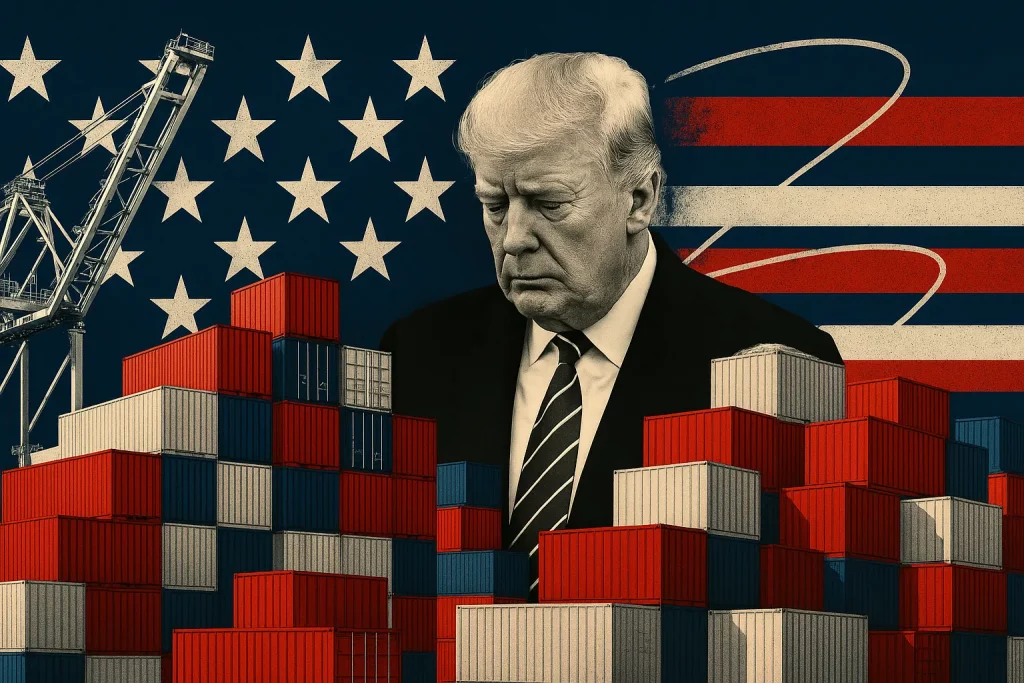Trump-Era Tariffs in 2025: How They Still Impact U.S. Businesses and Tax Planning

The Enduring Legacy of Protectionist Trade Policies
The U.S. economy remains partially affected by trade policies which the Trump administration established during its 2017-2021 presidential term. The protective trade measures put on more than $350 billion in imported products introduced a major divergence from previous international trade practices.
The extensive trade barriers implemented their purpose to balance imports and boost manufacturing output through increased prices on international products. Multiple sectors received numerous complicated outcomes from these measures which combined both advantageous and disadvantageous results.
The Biden administration has implemented certain modifications to trade policies mainly focusing on U.S. relations with European partners but the original tariff structure against Chinese industries and strategic manufacturing materials continues to remain in place. U.S. businesses operating in 2025 remain under a business environment defined by these elements:
- Ongoing disruptions in global supply chains.
- Persistent inflationary pressures on essential commodities.
- Non-standardized rules and tax regulations continue to alter in the business sector.
- Organizations face significant difficulties when obtaining materials from the currently fragmented global supply system.
The extensive research delivers deep evaluation about existing tariff effects which provides senior business officials essential navigational tools for the evolving economic landscape.
Understanding the Trump Tariff Framework
The Trump administration’s trade policy operates in three main tariff sectors which serve independent aims while affecting different industrial fields differently.
- The Section 232 Tariffs applied national security warrants to introduce these restrictions back in March 2018.
The Trump administration started imposing steel and aluminum import tariffs throughout March 2018 by implementing Section 232 of the Trade Expansion Act. National security concerns served as justification for the measures because U.S. defense infrastructure needed to decrease dependency on foreign metal imports.
- Steel Tariff: A 25% general tariff applied to all steel importations serves under the Steel Tariff.
- Aluminum Tariff: The aluminum import tariff imposes a comprehensive 10% duty on aluminum coming into the United States.
A strong portion of the initial tariffs put in by the Trump administration continues while several military-ally nations get waivers from certain tariffs.
- Section 301 Tariffs implemented two phases from 2018 through 2019 during China Trade Practice enforcement.
Because of its strong anti-China position the administration imposed these tariffs on $370 billion worth of products which were distributed across 1,300 different types of merchandise. Many Chinese imports face average import tariffs that stand at 25%.
The targeted sectors undergoing trade barriers consist of electronics products along with industrial machinery and consumer goods. These tariffs existed to stop intellectual property infringement along with imposing restrictions on forced technology sharing and fighting what the U.S. viewed as unjust Chinese trade practices.
The Biden administration holds modest efforts to lower Chinese trade barriers as the 2025 tariffs still protect about 60% of imported merchandise from China.
- Sector-Specific Protective Tariffs
Apart from the wide-spread Section 232 and Section 301 tariffs the trade policy included several targeted tariffs affecting specific product sectors.
- Residential Appliances: Portable washing machines face residential tariffs that amount to between twenty and fifty percent.
- Renewable Energy: The solar panel tariff began at 30% before the government reduced it to 15% later on.
- Forest Products: Forest Products: 20% tariff on Canadian softwood lumber.
The 2025 Business Environment: Six Key Impact Areas
These tariffs from the past have left a significant mark on the business environment during 2025. Multiple connected business challenges are currently remolding different sectors throughout the business landscape.
- Operational Cost Structures Under Sustained Pressure
Industrial businesses experience significant operational challenges because of these extended-term tariffs. The new tariffs have proven especially damaging to businesses that use foreign materials in their operations.
- Heavy Manufacturing: The steel-dependent heavy manufacturing sectors continue to encounter input expenses that are higher by 17-23% than their pre-tariff figures. Small- to mid-size manufacturers face particular difficulties as 45% have observed margin contraction based on The National Association of Manufacturers (NAM) survey from 2024.
- Consumer Durables Market: Household appliances in the consumer durables market maintain elevated prices by between 9% and 13% compared to 2017 prices. Six to eight percent additional costs affect the electronics sector which depends on Chinese-origin components due to tariffs on Chinese goods.
- Automotive Industry: Automotive manufacturers now need 2,850 dollars more to produce cars because of the materials affected by tariffs unless they maintain their pre-tariff production cost of 1,250 dollars. Electric vehicle companies face manufacturing difficulties due to 12-15% inflation within their battery chain supply systems.
The Midwestern industrial equipment producer documented a profit decrease of 19% while maintaining an 8% revenue increase because they needed to pay extra fees on imported steel.
- Global Supply Chain Reconfiguration Trends
Businesses redirect their supply chains internationally through alternative markets to decrease their costs due to the tariffs. Companies have increasingly explored:
- Nearshoring to Mexico: The partnership between Mexico and the United States has achieved significant growth because manufacturing trade volumes rose by 39% between 2020 and 2024. The logistics costs have risen between 18-22% while lead times have extended by 16-22 days because of customs delays.
- ASEAN Diversification: Since 2018 Vietnam has emerged as an essential trade destination for ASEAN because U.S. companies have amplified their exports to the country by 230%. The precision manufacturing capacity faces restricted boundaries and annual worker costs surpass 14% mark.
- Domestic Reshoring Efforts: 40% of manufacturers resumed local manufacturing operations but they continue to face skills shortages for 525,000 positions and production costs exceeding Asian levels by 35-45%.
Research done by the Reshoring Institute in 2024 revealed that only 14% of companies reached their expected cost-saving goals through reshoring yet the period needed for adjustment spanned from 20 to 26 months.
- Inflationary Dynamics and Consumer Impact
Tariffs have directly increased consumer prices in the market.
- Durable Goods Inflation: The analysis from the Federal Reserve in 2024 showed that durable goods experienced a 6.8% total price increase caused by tariffs and washing machine prices stayed elevated by 19% since the implementation of the measures.
- Commodity Market Pressures: The continued high prices of steel and aluminum materials above 2017 levels exert inflationary effects on the U.S. economy as a whole.
- Household Economic Impact: According to data from the Brookings Institution in 2024 the median-income households must spend an extra $850 yearly on products influenced by tariffs.
- Evolving U.S.-China Commercial Relations
The U.S.-China trade relationship develops further as both national governments work to achieve strategic separation between countries.
- Trade Volume Metrics: The total trading volume between the U.S. and China reached $695 billion during 2023 while the product composition changed over time. The proportion of intermediate components within this foreign trade has been increasing at the expense of finished goods.
- Strategic Decoupling Trends: There has been a 63% decrease in the U.S. imports of Chinese semiconductors while imports of Chinese medical technology products declined by 38%. Most companies choose a strategic de-risking strategy by maintaining chosen Chinese business relationships alongside the creation of supplementary supply networks.
- Sector-Specific Consequences
These trade restrictions heavily affect selected sectors within the market:
- Technology and Electronics: Technological products and electronic equipment now encounter Chinese-made semiconductor fees of 25% while data center infrastructure expenses grew 8-11%.
- Renewable Energy: The wind energy industry deals with significant import tariffs which affect essential components between 11-14% and battery production is limited by duties for essential minerals.
- Global Trade Pattern Shifts
Trade partnerships between nations together with shifts in worldwide trade enable businesses to explore new opportunities for market expansion.
- USMCA Utilization: The U.S.-Mexico-Canada Agreement (USMCA) now receives substantial usage as organizations plan to utilize it at an 81% rate in 2024.
- Indo-Pacific Economic Framework: The U.S. seeks to balance Chinese economic dominance in the Indo-Pacific region through its growing Indo-Pacific Economic Framework initiatives.
The organization should consider tax compliance measures while planning strategically for tax adjustments and compliance requirements.
In this time of uncertain trade situations businesses need to manage tax implications as well as resolve compliance needs stemming from tariffs
- Tariff Expense Deductibility Frameworks
- Section 301 Tariffs: Section 301 Tariffs produce deductible expenses which import-heavy businesses can use to lower their taxable income by between 16% and 26%.
- Section 232 Tariffs: Section 232 duties come under production costs (COGS) with precise accounting rules to follow.
- Transfer Pricing Complexities
- Atmosphere prices need to be proven honest in all international business deals with special attention to Asian suppliers. Non-compliance with Internal Revenue Service (IRS) regulations leads to heavy penalties for companies with evidence demonstrated by a multinational technology firm that reduced $4.3 million in penalties through proper transfer pricing documentation regarding tariffs.
- State and Local Tax Implications
- Revenue Impacts: States throughout the country have reported higher sales tax revenues from tariff-affected products whose prices rose. Meanwhile several geographical areas and regions are reporting declining revenue streams because consumer buying patterns are starting to change.
- Incentive Programs: The tax authorities of many states provide financial rewards to companies that restore their operations from overseas locations back to their domestic markets. The tax credit programs of Georgia delivered $12.7 million in support to battery manufacturing facilities that encountered impacts from mineral tariffs.
Strategic Response Framework for Business Leaders
The complicated environment demands business leaders to use an inclusive strategic method for effective navigation.
- Supply Chain Optimization Tactics
- Trade Agreement Utilization: Through USMCA businesses can save substantial amounts of duties which result in potential cost benefits between 17-22%.
- Foreign Trade Zone Advantages: When U.S. enterprises establish operations inside Foreign Trade Zones they gain reduced effective tariff rates via duty reductions between 32-52%.
- Tax Efficiency Maximization
- Duty Recovery Programs: The Duty Recovery Programs remain underutilized by 83% of eligible firms because businesses fail to recover up to 99% of their re-exported goods tariffs.
- Policy Engagement Strategies
- Exclusion Request Processes: The updated 2024 procedures enable companies to file exclusion requests for which approval rates reach 40%.
- Industry Collaboration: Trade organizations that businesses partner with enable their organizations to advance their advocacy work and obtain policy influence in national decision-making processes.
Forward-Looking Projections and Strategic Imperatives
Future businesses need to anticipate existing obstacles alongside future opportunities which emerge from strategic business readjustments.
- Political Considerations: Core tariff structures obtain bipartisan support indicating their continued existence in the foreseeable future but U.S.-China diplomatic relations might change based on election results.
- Economic Forecasts: The International Monetary Fund predicts that U.S. GDP will experience a limited annual rise of 0.35-0.55% because of the duties together with a manufacturing sector expansion of 2.2-2.4%.
Navigating the New Commercial Reality
The tariffs implemented during the Trump administration are now established as a long-term economic feature of the United States. Business success in 2025 will belong to companies which implement tariff planning as well as strategic tax optimization and continual supply chain risk evaluation. Through the adoption of innovative approaches alongside intense collaboration and strategic planning techniques businesses can convert trade environment challenges into competitive market advantages to lead the global market complexity.

